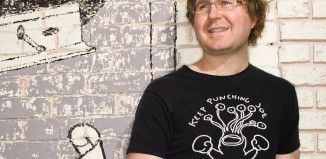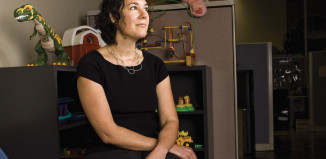There was a time when James Chestnut looked like the corporate version of an American success story: he had two college degrees, a high paying job, and a luxurious apartment in San Francisco. There was also a time, less than a year ago, when Chestnut looked like the kind of American our society all too easily forgets. And while today he is back on the road to health, that’s exactly what he was until Project Transitions came into his life: left out of a system that could have saved him, and resigned to death.
Project Transitions, an Austin nonprofit organization, provides housing, support, and hospice care for people living with HIV and AIDS. Chestnut’s first experience with Project Transitions came in the 1990’s, when his partner went there for hospice care. Later, Chestnut would himself become a resident in hospice. But with the help and care he received there, he beat the odds and is no longer a terminal patient.
Chestnut is a tall, affable, Austin native with a stylish haircut, neatly trimmed beard and a kind smile. He’s been asked to tell his story so many times that he delivers it directly, without any embellishment, although he’s quick to add that he wants to share his experiences out of gratitude and a hope that maybe he can reach someone who is going through what he’s gone through.
A UT grad, Chestnut worked in accounting, finance, and high tech in both Texas and San Francisco from the late 1980’s until 2010. His first accounting job out of school in the late 1980’s took him first to Dallas, and then San Francisco, where he met his first partner, a man named Robert.
“We had a good life there,” Chestnut says. “I was starting my career, and at that time we were both HIV negative.”
At some point, Chestnut doesn’t remember exactly when, Robert became HIV positive. This was before the modern drug cocktails, and HIV was akin to a death sentence.
“I started thinking if we’re ever going to pursue our dreams, we’d better do it now,” he says. “He and I had always talked about having a small business. I got the nerve to abandon my corporate career, and we picked up and moved back to Austin, where we opened Little City with two other business partners on Congress Avenue.”
Little City took off immediately when it opened in the fall of 1993, but at the same time, Robert’s health declined dramatically. Two months after the opening of the coffee shop that legislators and downtown workers frequented, Robert was in hospice care. In February of 1994 he died. Chestnut was still HIV negative.
“That was a pretty devastating time for me,” Chestnut recalls. “In the post-mourning period after his death, I decided I wanted to go back to California. I sold my interest of the business to my two partners and moved back to the Bay Area. And I really proceeded to spend the next several years living there.”
Chestnut picked up again where he’d left off in the corporate world, taking a job in the high tech industry and moving up the ladder quickly.
In the years that followed he would get involved in two other relationships, and move back and forth between Texas and the Bay Area a few more times. Right before moving back to San Francisco from Austin with his partner Dan in 2005, they both got a positive HIV diagnosis.
Nonetheless they both made the move back to San Francisco, with the news weighing on them. This time they weren’t living the dream that Chestnut had experienced before. His new job was extremely stressful, and required a lot of travel. Dan didn’t have the contacts Chestnut had in San Francisco, nor did he have a job, and he quickly fell into depression.
“We both turned to crystal meth,” Chestnut says. “It’s an all-too-common drug, especially in the gay community. Dan and I lived in California from 2005 until 2008, and during that time there was a slow progression of increased drug use, to the point where we were both injecting crystal meth daily.”
Chestnut was earning a good salary, so he could afford the habit. “Everyone has a preconceived notion of what a drug user looks like,” Chestnut says,” And they don’t expect it to be a white guy with a good job. But I was doing the same streets drugs as someone in a gutter – I was just doing it in my $1 million apartment.
Until that point Chestnut had been relatively healthy, even with the positive HIV diagnosis. He had health insurance through his job, and he was seeing a doctor. His viral load numbers were low enough that he didn’t need to be on the anti-retroviral drug cocktail yet. But the drugs had weakened him, and a bad staph infection weakened him further, so Chestnut’s doctor decided to start him on the cocktail.
Dan went on the HIV meds too, but the job stress and Dan’s depression kept spiraling downward. Chestnut knew they couldn’t keep going like that, and when Dan moved back to Texas he checked himself into a drug rehab center outside of Portland, Oregon.
That was in the summer of 2009, and it was the last time Chestnut touched drugs – an astounding rebound, considering less than a quarter of crystal meth users injecting on a daily basis survive, let alone stay sober.
Chestnut again moved back to Austin to stay with his parents, the last time he would make the bounce from California to Texas. He was on unemployment and was insured through Cobra, a continuation of health insurance benefits that allows former employees to temporarily keep their health benefits. But the recession wasn’t easing up, and he couldn’t find a job. There were a lot of bleak numbers appearing in the news in 2010 into 2011, and Chestnut was one of them: one of the many former white-collar workers who could no longer find work.
In the summer of 2011, after 18 months on Cobra insurance coverage, the extension ran out, and faced with paying $3,500 a month for his HIV medication, Chestnut stopped buying the meds.
“For years I was covered under a fat health plan for my employer. Life is good when your employer is paying the costs, and I had great coverage,” Chestnut says. “The minute I stepped outside of that, I couldn’t get health care if my life depended on it, and my life did depend on it.”
He began experiencing painful stomach cramping, but he put it off when his oldest brother committed suicide. He helped make arrangements for his brother’s four children, and then could no longer ignore the pain. He had an ulcerated colon, and went into septic shock. After an emergency colon surgery he spent 40 days in the hospital, and thought he’d dodged a bullet. Things seemed to be healing, and his doctors reattached his colon.
That’s when things went downhill fast for Chestnut. He was experiencing pain, and was losing control of his bowels. He had the sensation of his stomach and upper intestine turning into concrete. Yet doctor after doctor sent him on his way with no explanation for the pain. After more than 15 trips to emergency rooms and doctor’s offices, he gave up. He was completely incontinent and in severe pain.
Chestnut was now bedridden, and for 18 months he didn’t leave the bedroom in his parents’ house. He could no longer eat, he was literally lying in his own waste, he lost 80 pounds, and his parents had no idea how to help him. By nine months into lying in bed and staring at the ceiling, he stopped communicating altogether.
As it turns out Chestnut’s insides were turning into something like concrete. His entire gastro intestinal system was compacted with food waste, and his body, desperate to find a way to rid itself of toxins, developed a fistula, an abnormal connection between an organ, vessel, or intestine and another structure. In Chestnut’s case the fistula was in his lower left leg, and his bowels tried to empty themselves through that hole. But no one knew he had the fistula, not even Chestnut. He had ground his molars to pieces to get through the pain, but the pain didn’t abate. He simply lay in bed and wished for the end to come.
Finally, after 18 months, Chestnut’s mother called a crisis intervention team. Along with a police officer and social worker, a medical team took Chestnut, wasted away to 140 pounds, out of the house and into the hospital.
Although he was finally receiving the care he desperately needed, Chestnut still wasn’t communicating. Someone sat in his room 24 hours a day because he was thought to be a suicide risk, and a psychiatrist came to evaluate him. On the first day she tried to ask him questions he didn’t even open his eyes.
“In the next session she said ‘look, I’m here to evaluate your sanity, and if I deem you are not in possession of your mental capacity, they’re going to discharge you to a mental hospital. As bad as it is here, it’s going to be worse there. If there’s ever a time to start talking, it’s now,” Chestnut says. “It took me five seconds. I turned to her and said ‘what do you want to know?’ We talked for two hours.”
Finally, there was a glimmer of hope for Chestnut’s prognosis. Now that he was communicating he was able to make more health care decisions on his own, and doctors were able to start healing his intestinal system. Before they could even do a scope to see what was causing his pain, they had to empty his intestinal tract, a process that meant seven days of enemas and oral medications that flushed his bowels into a tub underneath him.
Once the doctors could examine his GI tract, they discovered it was ruined, and that he had colorectal cancer. His doctors thought that chemotherapy would probably kill him, and once again, he faced a bleak prognosis.
Chestnut was now speaking and taking a more proactive role in his healthcare, but he was still in such intense pain that he planned to die. When the hospital discharged him to a nursing home – one he won’t name, but didn’t give him the care he needed even at a cost of $1,400 a day – he told his oncologist that he didn’t want to pursue cancer treatment if it meant living with more pain.
That’s when Project Transitions came into Chestnut’s life. A social worker at the nursing home had worked at Doug’s House, Project Transition’s hospice, and recommended him as a patient there. He was familiar with Doug’s House – it’s where his first partner, Robert, lived out his last days when he was dying of AIDS. Now it was Chestnut’s turn to take up residence there, with a prognosis of less than four months to live.
That was six months ago, and Chestnut has made the kind of turnaround that’s often called miraculous. He’s received surgery to remove 15 cancerous lymph nodes and cancerous colorectal tissue; he’s back on HIV medication; and he’s in counseling to mend his relationship with his parents. He’s no longer a resident at Doug’s House, since he’s no longer expected to die imminently.
Project Transitions worked with him to provide counseling, assistance with HIV medication, help getting disability payments, and a place to heal from the cancer surgery he received in October. And now that he’s stronger, Chestnut has been volunteering several times a week at Doug’s House doing direct patient care and helping to fundraise.
“I’ve maintained my relationship with Project Transitions,” Chestnut says. “They really saved my life. They got me to a place where I felt cared for and treated, they put me in touch with the right doctors. And I have a good, full, normal life now.”



































